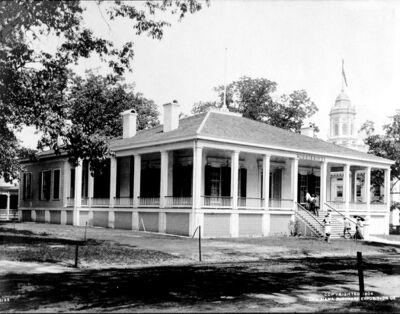Mississippi: Difference between revisions
(Created page with "{{short description|Mississippi State Building}} {{Infobox prepared food | name = Mississippi State Building | image = Mississippi State Building.jpg | image_size = 300px | caption = Mississippi State Building | alternate_name = | country = | creator = | course = | cost = $15,000 ({{Inflation|US|15,000|1904|fmt=eq}}) | admission = | profit = | owner = | main...") |
No edit summary |
||
| Line 1: | Line 1: | ||
{{short description|Mississippi State Building}} | {{short description|Mississippi State Building}} | ||
{{Infobox | {{Infobox FairBuilding | ||
| name = Mississippi State Building | | name = Mississippi State Building | ||
| image = Mississippi State Building.jpg | | image = Mississippi State Building.jpg | ||
| image_size = | | image_alt = | ||
| image_size = 400px | |||
| caption = Mississippi State Building | | caption = Mississippi State Building | ||
| alternate_name = | | alternate_name = | ||
| | | location = [[Plateau of States]] | ||
| | | no_buildings = | ||
| | | construction_cost= $15,000 (${{Format price|{{Inflation|US|15,000|1904}}}} in {{Inflation/year|US}}) | ||
| furnishing_cost = | |||
| | |||
| profit = | | profit = | ||
| owner = | | owner = | ||
| | | architect = John F. Barnes, of Jackson | ||
| | | dimensions = 90' x 90' | ||
| | | adult_entry = | ||
| child_entry = | |||
| opening_day = | |||
| dedication_day = | |||
| special_day = | |||
| other = | | other = | ||
}} | }} | ||
Mississippi's entry was situated south of the [[Iowa]] building and east of [[New Jersey]], off the [[Plateau of States]]. It was used as the headquarters for visitors from the State of Mississippi. | |||
==Description== | ==Description== | ||
Reproduced as a copy of | Reproduced as a copy of 'Beauvoir', the old-style southern mansion bequeathed to Jefferson Davis on the gulf coast by Mrs. S. A. Dorsey (The Confederate President spent the last years of his life there), and where he wrote 'The Rise and Fall of the Southern Confederacy'. It was built entirely of Mississippi lumber. | ||
The Mississippi building house a considerable number of artifacts from | The Mississippi building house a considerable number of artifacts from Davis' life, loaned by the widow of the President of the Confederacy of note was: a hundred year old piano, punch bowels, sideboards, etc. Included was Davis' suit of clothes that he wore when he was captured by General Wilson, in Georgia at the close of the Civil War; the object of the exhibit being to disprove the report that to hide, Mr. Davis wore a woman's dress when arrested. | ||
The library, bedroom and dining hall were almost intact, | The library, bedroom and dining hall were almost intact, with furnishing coming from 'Beauvoir'. | ||
In the Palace of Agriculture two exhibits were shown, the special cotton exhibit, including the 35-foot statue of "King Cotton," and the vast collective agricultural exhibit of: cotton, corn, cereals, grains, hay, grasses, potatoes, peas, beans, syrups, honey, wines, cordials, preserves, pickles, jellies, canned goods, vegetables, oysters, shrimps, crabs, fish, etc. | In the Palace of Agriculture two exhibits were shown, the special cotton exhibit, including the 35-foot statue of "King Cotton," and the vast collective agricultural exhibit of: cotton, corn, cereals, grains, hay, grasses, potatoes, peas, beans, syrups, honey, wines, cordials, preserves, pickles, jellies, canned goods, vegetables, oysters, shrimps, crabs, fish, etc. | ||
Latest revision as of 05:40, 17 November 2022
 | |
| Location | Plateau of States |
|---|---|
| Construction | |
| Construction Cost | $15,000 ($452,389 in 2021) |
| Architecture | |
| Architect | John F. Barnes, of Jackson |
| Dimensions | 90' x 90' |
Mississippi's entry was situated south of the Iowa building and east of New Jersey, off the Plateau of States. It was used as the headquarters for visitors from the State of Mississippi.
Description[edit | edit source]
Reproduced as a copy of 'Beauvoir', the old-style southern mansion bequeathed to Jefferson Davis on the gulf coast by Mrs. S. A. Dorsey (The Confederate President spent the last years of his life there), and where he wrote 'The Rise and Fall of the Southern Confederacy'. It was built entirely of Mississippi lumber.
The Mississippi building house a considerable number of artifacts from Davis' life, loaned by the widow of the President of the Confederacy of note was: a hundred year old piano, punch bowels, sideboards, etc. Included was Davis' suit of clothes that he wore when he was captured by General Wilson, in Georgia at the close of the Civil War; the object of the exhibit being to disprove the report that to hide, Mr. Davis wore a woman's dress when arrested.
The library, bedroom and dining hall were almost intact, with furnishing coming from 'Beauvoir'.
In the Palace of Agriculture two exhibits were shown, the special cotton exhibit, including the 35-foot statue of "King Cotton," and the vast collective agricultural exhibit of: cotton, corn, cereals, grains, hay, grasses, potatoes, peas, beans, syrups, honey, wines, cordials, preserves, pickles, jellies, canned goods, vegetables, oysters, shrimps, crabs, fish, etc.
In the Palace of Forestry, Fish and Game, the state showcased over 500 samples of highly polished timber, superbly finished, one of the largest and best collections shown.
